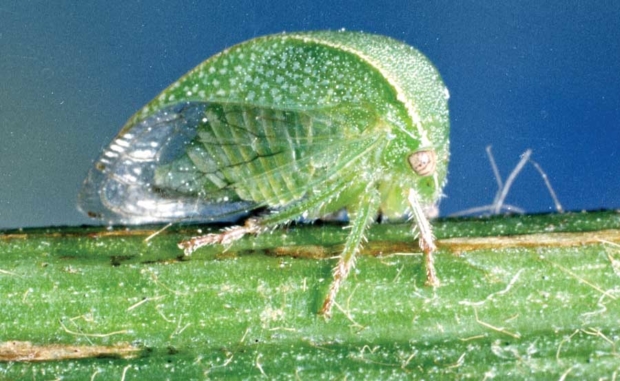
The three-cornered alfalfa treehopper (Spissistilus festinus) has been confirmed as a vector for red blotch disease, but researchers say there may be others. (Courtesy of Clemson University, USDA)
Researchers at the University of California, Davis, have identified the three-cornered alfalfa treehopper (Spissistilus festinus) as the first known vector for red blotch-associated virus in greenhouse experiments.
The researchers caution that the discovery does not mean the treehopper is the only vector. However, the finding opens new avenues for research to help control both the virus and the pest in areas it is known to roam.
The hopper is native to North America, but its range has largely been restricted to the southern U.S. That aligns with the spread of the virus in California and Oregon, said entomology postdoctoral researcher Brian Bahder.
He spoke in February during a webinar sponsored by the University of California at Davis and the U.S. Department of Agriculture’s Agricultural Research Service.
Red blotch disease was first recognized in 2008 in a Napa Valley, California, vineyard. After being confirmed as a new virus in 2011, the disease is now present in many major grape production regions of the U.S. and Canada.
Leaf symptoms first appear around midsummer, though that differs by cultivar and by year. In red grape cultivars, common symptoms include red blotches originating from the leaf margin. In white grape cultivars, pale green to pale yellow patches appear.
The disease is not known to kill grapevines; however, there is a known effect on the wine produced from fruit on diseased grapevines: Total soluble solids are consistently reduced, and pH and titratable acidity are also variable.
Bahder showed graphics that highlighted the spread of the disease in California vineyards, including the UC Davis research vineyard in Oakville, a vineyard in Amador County, and a third vineyard in Santa Barbara.
Of the latter, Bahder said the vineyard had been healthy for 70 years. “Then, in the last few years, they brought in new material from a nursery, planted it, and you can see that all of sudden, you get a cluster on the edge of the vineyard, which is indicative of a vector.”
The search for a vector
Bahder focused his greenhouse tests on five species that he suspected were potential vectors for the disease, including the treehopper (a member of the Membracidae family), two species of leafhoppers (Cicadellidae), one jumping plant lice (Psyllidae) and a planthopper (Cixiidae).
For the experiments, Bahder placed one insect from each of these species in a greenhouse with infected vines for 48 hours, then moved them to a greenhouse with uninfected vines for another 48 hours. Just one, the treehopper, transmitted the virus to three out of 15 plants.
Bahder tested for red blotch disease using digital PCR, which he said is more sensitive than quantitative PCR; however, he didn’t start detecting red blotch until three months after inoculation, and even then, it was at an extremely low concentration.
The finding was particularly interesting, Bahder said, because grapes are not the preferred host for the species. The three-cornered alfalfa treehopper prefers legumes, grasses and, befitting its name, alfalfa — plants found in riparian areas on the edges of vineyards.
That may help to explain distribution of the disease in vineyards, he said.
What does it mean?
There is no record of the three-cornered alfalfa treehopper in Washington. “There’s something precluding it from being here,” Washington State University entomologist Doug Walsh said. To the south in Oregon, the disease is spreading some in the Willamette Valley and the Rogue River Valley.
In California vineyards, the treehopper has long been viewed as merely a nuisance. Generally, growers were not advised to spray for the pest because it was rare that populations were high enough to cause significant damage to the vines, said UC Davis entomologist Frank Zalom.
“They were usually reported as a minor pest,” he said, referring to the situation in that state. “It hasn’t been a significant problem, but it’s going to be a lot more important problem now.”
Since the announcement, researchers already have confirmed that the pest overwinters in vineyards, which was previously unknown, and found overwintering adults that were infected with the virus in the salivary glands. That would mean they are capable of spreading the virus, Zalom said.
Going forward, more research will center on the biology of the treehopper, such as whether adults can transfer the virus through eggs to nymphs, and when nymphs and adults move from ground cover to the vines themselves. •
– by Shannon Dininny






Shannon we loved your article so much that we featured it on our Sunburst Plant Disease Clinic Facebook page.
Thank you for the information you provide. It’s not only empowering but enlightening to plant disease specialists.
http://www.sunburstpdcinc.com/about.php